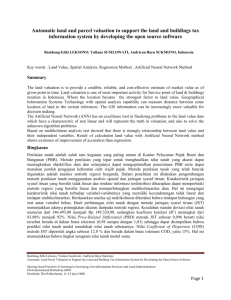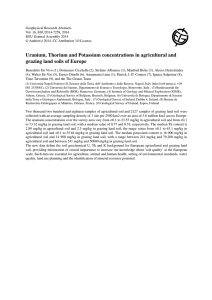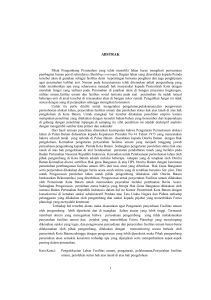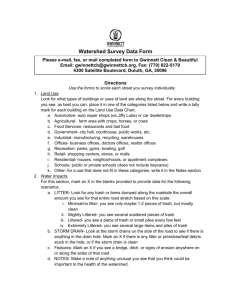Automatic Land and Parcel Valuation to Support the Land and
advertisement
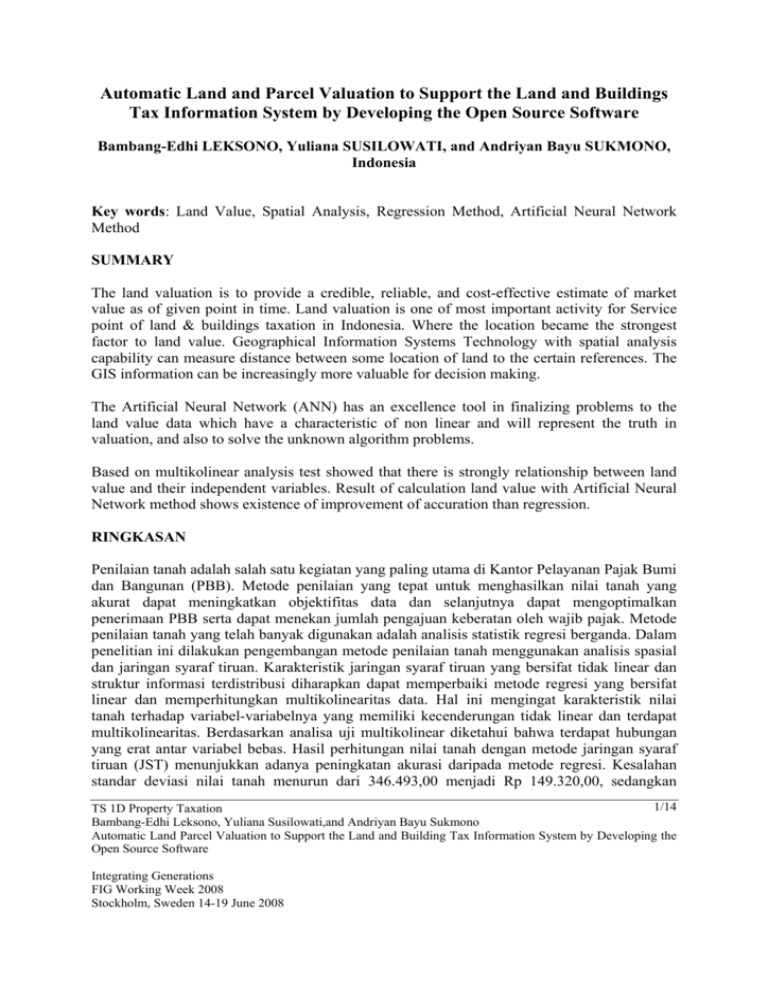
Automatic Land and Parcel Valuation to Support the Land and Buildings Tax Information System by Developing the Open Source Software Bambang-Edhi LEKSONO, Yuliana SUSILOWATI, and Andriyan Bayu SUKMONO, Indonesia Key words: Land Value, Spatial Analysis, Regression Method, Artificial Neural Network Method SUMMARY The land valuation is to provide a credible, reliable, and cost-effective estimate of market value as of given point in time. Land valuation is one of most important activity for Service point of land & buildings taxation in Indonesia. Where the location became the strongest factor to land value. Geographical Information Systems Technology with spatial analysis capability can measure distance between some location of land to the certain references. The GIS information can be increasingly more valuable for decision making. The Artificial Neural Network (ANN) has an excellence tool in finalizing problems to the land value data which have a characteristic of non linear and will represent the truth in valuation, and also to solve the unknown algorithm problems. Based on multikolinear analysis test showed that there is strongly relationship between land value and their independent variables. Result of calculation land value with Artificial Neural Network method shows existence of improvement of accuration than regression. RINGKASAN Penilaian tanah adalah salah satu kegiatan yang paling utama di Kantor Pelayanan Pajak Bumi dan Bangunan (PBB). Metode penilaian yang tepat untuk menghasilkan nilai tanah yang akurat dapat meningkatkan objektifitas data dan selanjutnya dapat mengoptimalkan penerimaan PBB serta dapat menekan jumlah pengajuan keberatan oleh wajib pajak. Metode penilaian tanah yang telah banyak digunakan adalah analisis statistik regresi berganda. Dalam penelitian ini dilakukan pengembangan metode penilaian tanah menggunakan analisis spasial dan jaringan syaraf tiruan. Karakteristik jaringan syaraf tiruan yang bersifat tidak linear dan struktur informasi terdistribusi diharapkan dapat memperbaiki metode regresi yang bersifat linear dan memperhitungkan multikolinearitas data. Hal ini mengingat karakteristik nilai tanah terhadap variabel-variabelnya yang memiliki kecenderungan tidak linear dan terdapat multikolinearitas. Berdasarkan analisa uji multikolinear diketahui bahwa terdapat hubungan yang erat antar variabel bebas. Hasil perhitungan nilai tanah dengan metode jaringan syaraf tiruan (JST) menunjukkan adanya peningkatan akurasi daripada metode regresi. Kesalahan standar deviasi nilai tanah menurun dari 346.493,00 menjadi Rp 149.320,00, sedangkan 1/14 TS 1D Property Taxation Bambang-Edhi Leksono, Yuliana Susilowati,and Andriyan Bayu Sukmono Automatic Land Parcel Valuation to Support the Land and Building Tax Information System by Developing the Open Source Software Integrating Generations FIG Working Week 2008 Stockholm, Sweden 14-19 June 2008 koefisien korelasi (R2) meningkat dari 83.88% menjadi 92%. Nilai Price-Related Differential (PRD) metode JST sebesar 0,996 berarti nilai tersebut berada di dalam batas toleransi (0,98 sampai dengan 1,03) sehingga dapat disimpulkan bahwa prediksi nilai tanah model mendekati nilai tanah sebenarnya. Nilai Coefficient of Dispersion (COD) metode JST diperoleh angka sebesar 12.8 % dan berada dalam batas toleransi COD, yaitu 15%. Hal ini menunjukkan bahwa tingkat seragram nilai tanah model sama. 2/14 TS 1D Property Taxation Bambang-Edhi Leksono, Yuliana Susilowati,and Andriyan Bayu Sukmono Automatic Land Parcel Valuation to Support the Land and Building Tax Information System by Developing the Open Source Software Integrating Generations FIG Working Week 2008 Stockholm, Sweden 14-19 June 2008 Automatic Land and Parcel Valuation to Support the Land and Buildings Tax Information System by Developing the Open Source Software Bambang-Edhi LEKSONO, Yuliana SUSILOWATI, and Andriyan Bayu SUKMONO, Indonesia 1. INTRODUCTION The purpose of land valuation is to provide a credible, reliable, and cost-effective estimate of market value as of given point in time. One of most widely used method for land valuation models is Multiple Regression Analysis (MRA). MRA Weakness is consider multicollinearity problem, can be influenced by outlier, and calculates linear correlation of variable. These weakness can cause level of accuration of regression to become decreasing. Land valuation is one of most important activity for Kantor Pelayanan Pajak Bumi and Bangunan ( PBB). This activity influences success of other activitys, like decision-making of potential PBB, acceptance PBB and service to taxpayer. High Accuration Valuation causes existence of amenity in doing prediction of acceptance of PBB and lessens proffering is objecting by taxpayer. Location is “strongest” factor to land value (Hidayati, 2003). Location variable can be interpreted as relative situation a land area to certain reference and it can be defined as distance between a land area to the reference. Geographical Information Systems Technology with spatial analysis can measure land area to reference. GIS information can become increasingly more valuable for decision making when couple to artificial intelligence. GIS and artificial intelligence can be useful for evaluating, monitoring and decision making. One of method in artificial intelligence is artificial neural network. Artificial neural network has excellence in solving problems which contains uncertainty, inaccurate and partial truth ( Kusumadewi, 2006). ANN Computation applies approach of pattern recognition to solve problem. ANN learn patterns in data during training process by propagating it to some associative neurons at the same time. One of characteristic ANN is not linear and can solve unknown algorithm problems. The purpose of this research is to develop land valuation method using spatial analysis and artificial neural network. Problems which can be solved is: − − − − How land Value Characteristic? What Variable is having a significant effect to land value? How Multiple regression land value model and Artificial Neural Network Model? How much accuration of Multiple regression land value model and Artificial Neural Network Model? 3/14 TS 1D Property Taxation Bambang-Edhi Leksono, Yuliana Susilowati,and Andriyan Bayu Sukmono Automatic Land Parcel Valuation to Support the Land and Building Tax Information System by Developing the Open Source Software Integrating Generations FIG Working Week 2008 Stockholm, Sweden 14-19 June 2008 2. RESEARCH METHOD Research method used is shown in Figure.1. Persiapan Pengumpulan dan Verifikasi Data Pemodelan Nilai Tanah Perancangan Model Konseptual Nilai Tanah Model Konseptual Nilai Tanah Model Regresi Model Jaringan Syaraf Tiruan Perancangan Model Matematis Nilai Tanah Perancangan Model Matematis Nilai Tanah Model Matematis Nilai Tanah Model Matematis Nilai Tanah Konstruksi Model Nilai Tanah Konstruksi Model Nilai Tanah Model Awal Nilai Tanah Model Awal Nilai Tanah Analisis Model Nilai Tanah Analisis Model Nilai Tanah Model Nilai Tanah yang Valid Model Nilai Tanah yang Valid Penerapan Model Nilai Tanah Penerapan Model Nilai Tanah Model Nilai Tanah yang Valid Model Nilai Tanah yang Valid Analisis Hasil Pemodelan Menggunakan Model Regresi dan Model JST Model Penilaian Tanah menggunakan Model JST Nilai Tanah Figure 1. Research Method Research is done at District of Lengkong on Bandung City. District Map of Lengkong shown. The Data reqirurements are PBB data spatial, List Result of PBB Tax Object Record, Road Network Map, and Land Data Transaction. 4/14 TS 1D Property Taxation Bambang-Edhi Leksono, Yuliana Susilowati,and Andriyan Bayu Sukmono Automatic Land Parcel Valuation to Support the Land and Building Tax Information System by Developing the Open Source Software Integrating Generations FIG Working Week 2008 Stockholm, Sweden 14-19 June 2008 Factors influencing land value can be grouped to four categories, that is Physics, Economy, Social and Politics (Figure 2) (Eckert et al., 1990; Hidayati, 2003). Politik privasi konstruksi Tanah Sudut kontur Penjenjangan Drainase Fisik Topografi Keadaan tanah Pemandangan Plottage Saluran Saluran Gas Saluran Listrik Utilitas Saluran Telpone Suara Udara Pst Jalan Rumah Sakit Sekolah Polusi Nilai Land Use Tanah Angkutan Jalur Lalu Jarak Hak Milik Lokasi Kebijakan Legal HGB Keamanan HAK PAKAI Kesenj Sosial Sosial Kebudayaan Kepadatan Pend Demografi Pendapatan Pend Kesemp Kerja Fasilitas kredit Ekonomi Keg Ekonomi Figure 2 Conceptual Models of Land Value 5/14 TS 1D Property Taxation Bambang-Edhi Leksono, Yuliana Susilowati,and Andriyan Bayu Sukmono Automatic Land Parcel Valuation to Support the Land and Building Tax Information System by Developing the Open Source Software Integrating Generations FIG Working Week 2008 Stockholm, Sweden 14-19 June 2008 Figure 3 Research Location 3. RESULT AND ANALYSIS 3.1 Result of Data Verification of Land Value Data Relation between data transaction (PPAT) with Selling Value (NJOP) PBB in the year 2006 having the character of linear. Correlation coeficient, R2, the relation of PPAT and NJOP is the equal to 95%, while buyers offer and NJOP is 89%. If data PPAT and seller offer are merged, Sales data correlation coefficient becomes 65%. If it is seen from data spreading, the seller offer data is more disseminatingly than PPAT data.. Standard deviation of Seller Offer data is Rp.900.888,00, PPAT data is Rp. 791558,00, so that standard deviation of transaction data becomes Rp. 1.012.576,00. Therefore, seller offer data and PPAT need to be adjusted. Adjustment passed to the transaction data covers adjustment of time and adjustment of data. Adjustment of time applies rule applied in Circular Letter of Director-General of Number Tax: SE-55/PJ6/1999 about the handbook of analysis determination for Average indication value (NIR). All of these research the transaction data is specified on certain assessment, where the date of calculation is commencing at 1 January 2007 for the land assessment. 6/14 TS 1D Property Taxation Bambang-Edhi Leksono, Yuliana Susilowati,and Andriyan Bayu Sukmono Automatic Land Parcel Valuation to Support the Land and Building Tax Information System by Developing the Open Source Software Integrating Generations FIG Working Week 2008 Stockholm, Sweden 14-19 June 2008 Adjustment for data type is done by using regression analysis. Based on regression analysis, adjustment of data type for PPAT is 20%, while for seller offer equal to 22%. The relation of transaction data after adjustment of data the year 2007 with NJOP of land was dated in the year 2006 as shown at Figure- 4. SCATTERED DIAGRAM OF TRANSACTION DATA SELLING VALUE OF LAND (NJOP) PER METRE IN 2006 8000000 7000000 NJOP6000000 2006 5000000 4000000 3000000 2000000 1000000 0 0 1000000 2000000 3000000 4000000 5000000 6000000 7000000 8000000 TRANSACTION DATA I Figure 4. Relationship of Sales Data and NJOP in 2006 3.1 Result of Model Design At this research, land value determinant selected is the accessibility, what consisted of distance to Commerce Center, distance to Main road and distance to College. Meanwhile, political factor, economics, social and public culture, assumed gives influence that is same relatively to one administration regions of district because this factors is difficult to be measured and existence of limitation of time, and expense. Object taken as as independent variable is : a. Center Commerce ( 3 Object) : Bandung supermall, plaza, market kosambi b. School ( 27 Objects): SDN Suryalaya, SD VI Cijagra, SMP Negeri 28, Sekolah, SMUN 8, SMKN 3 Bandung, SMKN 8 Bandung, SMP Negeri 13 Bandung, SMEA Binawarga, SMKN 2, SDN Putraco, SDN Pelita, SD Buah Batu Baru, Yayasan Pendidikan Kebangsaan, SD Terang I-II, SDN II-IV Turangga, SDN Turangga I 3, SDN Halimun I S/D 8, YPPM, SD BPI, SDN, SMP YPM, Yayasan Perguruan Taman Siswa, SMP, SD Nilem, SD Lengkong Kecil, SMAN 07 c. University ( 4 Object) : STIE Nasional, Universitas Pasundan, Universitas Langlang Buana 7/14 TS 1D Property Taxation Bambang-Edhi Leksono, Yuliana Susilowati,and Andriyan Bayu Sukmono Automatic Land Parcel Valuation to Support the Land and Building Tax Information System by Developing the Open Source Software Integrating Generations FIG Working Week 2008 Stockholm, Sweden 14-19 June 2008 d. Health Facility ( 7 Object) : Puskesmas Kec Lengkong, Puskesmas Suryalaya, Puskesmas Cijagra Baru, RS Bersalin, Puskesmas Cijagri Lama, Klinik Laboratorium, RS Muhamadiyah e. street ( 17 Objects) : Jl Dalem Kaum, Jl. Gatot Subroto, Jl. Palasari, Jl. Lodaya, Jl. Cikawao, Jl. Talaga Bodas, Jl. R A A Martanegara, Jl. Jend. A. Yani, Jl. Karapitan, Jl. Burangrang, Jl. Sada Keling, Jl. Buah Batu, Jl. KH A Dahlan, Jl. Lengkong Kecil, Jl. Lengkong Besar, Jl. Gurame, Jl. Asia Afrika, Jl. Turangga, Jl. Sukarno Hatta, Jl. Pelajar Pejuang 3.2 Modelling 1. Regression Land Value Model Based on result of land value determinant factors influence analysis, knowable that factors influencing land value are Sekolah and distance to street group of 4 or street having wide 12m. But factor influence center commerce, college and health facility need to be analysed furthermore in model forming. Variable taken away from third factor is variable having big correlation. At factor aparts to center commerce, variable aparts to plaza to have the biggest correlation coefficient. At factor aparts to college, variable aparts to university Langlang Buana and distance to university Pasundan has the biggest correlation coefficient. While at aparting to health facility, aparts to puskesmas district of lengkong has the biggest correlation coefficient. Choosing a model matching with doing regression to dependent variables ( NT) and its(the independent variable with four alternative of model who has been made or modeled that is linear model, model Log – Line, model Lin-Log and model Double Log. Based on result of this regression obtained coefficient value each variable with sign (+) or (-), value t, F value, and also coefficient of determination ( R2). Choosing a model is determined by comparing level of value R2. Good Model is model who is having higher R2 value. Table 1 Test Result F and Test t-statistik Uji R R2 F RMS Lin-Lin 0.891 0.794 0 349321 Log-Lin 0.857 0.734 0 399421 Log-Log 0.896 0.802 0 346508 Lin-Log 0.915 0.838 0 308829 Based On Above 1 tables, hence model which having highest correlation coefficient value is model Lin-Log with value R2 = 83.8%. R2 which is high enough indicates that joinly all independent variables has power clearly which is high enough in explaining variable is not its free is assessing soil;land;ground (NT). While low RMS value is logarithms model, that is 308829. Result of uji-multikolinearity to only one independent variables in model lin-log and 8/14 TS 1D Property Taxation Bambang-Edhi Leksono, Yuliana Susilowati,and Andriyan Bayu Sukmono Automatic Land Parcel Valuation to Support the Land and Building Tax Information System by Developing the Open Source Software Integrating Generations FIG Working Week 2008 Stockholm, Sweden 14-19 June 2008 logarithms that is is not is found existence of multikolinearity symptom, that is variable aparts to SD Nilem. Therefore, at test multikolinear most all variables doesn't get away test. The that is becoming lacking of linear regression method. Good examination entirety tested apriori economics, statistical test and also classic assumption test of shows that there is no variable getting away all examinations 2. Artificial Neural Network Land Value Model of Backprogation Land value determinant factors influence analysis process marginally divided to become 2 phase. First phase is analysis subfactor influencing land value in significant. Object significantly influencing land value in and chosen to be analysed phase hereinafter is object having R2 more than 50% (Tabel 2 ). Table 2 Chosen object No KODE RMS Commercial Centre 1 CBD3 459666 School 1 S3 539790 2 S4 453249 3 S7 493454 4 S9 520449 5 S11 349673 6 S17 516216 7 S18 467426 8 S20 527206 9 S21 543372 10 S22 510615 11 S24 490311 University 1 PT2 533698 2 PT3 533316 3 PT4 488521 Health facility 1 K4 530963 2 K6 490272 Road 1 J13 517031 2 J31 504021 3 J32 536656 4 J44 463012 5 J46 547895 R2 0.643 0.507 0.654 0.589 0.542 0.793 0.550 0.631 0.532 0.501 0.559 0.594 0.519 0.520 0.603 0.524 0.595 0.550 0.571 0.514 0.638 0.493 9/14 TS 1D Property Taxation Bambang-Edhi Leksono, Yuliana Susilowati,and Andriyan Bayu Sukmono Automatic Land Parcel Valuation to Support the Land and Building Tax Information System by Developing the Open Source Software Integrating Generations FIG Working Week 2008 Stockholm, Sweden 14-19 June 2008 No 6 KODE J47 RMS 476183 R2 0.617 After obtaining data from land object, the correlation shows a bit higher to the land value, that was done by Artificial Neural Network Model. The Artificial Neural Network Structure consisted of 23 node at input layer, 1 output layer and 1 hidden layer, with 46 node at hidden layer. Data applied in making of model or training amounts is 140. Result of prediction of land value by using artificial neural network models has value R2 09.2 %. While assessing mistake of RMS result of prediction Rp. 149320,00. Test of multicolinear cannot be done because relation between land determinant variable with land value doesn't have the character of linear. 3. Comparison of Regression Land Value Model and ANN Shortly, difference of regression model and ANN can be see at table : Table 3 Comparison of Models Test Multicolinearity Linearity Outlier Data Mathematical Equation RMS R2 Regression High Linear Unpredictable Y = f(X) Mean= 375.656 Mean= 79% ANN Not Tested not Linear predictable Y=g(f(X)) 149.320 92% After model have been made, land value model applied in predicting land value in district of Lengkong in the year 2007. At model applying, regression model analysed is lines model. Table-4 shows description of regression model statistic and model ANN. Table 4 Description of land Value Model Statistic Regresion ANN Min -324,437 202,791 Max 8,482,777 5,341,251 Mean 1,572,858 1,647,985 NJOP 243,000 6,805,000 1,189,058 Land value predicted by regression model there is negativity value. Regression minimum value is – 324.437,00. The value doesn't express land value that is actually because land value shouldn't valuable of negativity. Value which more closing is reality predicted by 10/14 TS 1D Property Taxation Bambang-Edhi Leksono, Yuliana Susilowati,and Andriyan Bayu Sukmono Automatic Land Parcel Valuation to Support the Land and Building Tax Information System by Developing the Open Source Software Integrating Generations FIG Working Week 2008 Stockholm, Sweden 14-19 June 2008 soil;land;ground value model ANN. Minimum Value ANN is Rp. 202.791,00 and almost near minimum value NJOP 2006. Implementation of regression land value model and ANN for PBB is done with converting land value result of prediction of model into land class. land class yielded by regression model is more varies than model ANN. Example of various visible land class at Figure- 5. The Area encircled is example of area with various highvalue of land class. That Condition can cause conflict between taxpayers against the exercise officer. Variasi Kelas Figure 5 Regression of Land value ( Land valuation class map) Various lower value of land valuation class is obtained by using valuation of model ANN. The Figure below shows land valuation class map by ANN. 11/14 TS 1D Property Taxation Bambang-Edhi Leksono, Yuliana Susilowati,and Andriyan Bayu Sukmono Automatic Land Parcel Valuation to Support the Land and Building Tax Information System by Developing the Open Source Software Integrating Generations FIG Working Week 2008 Stockholm, Sweden 14-19 June 2008 Figure 6 Land Valuation Class Map by ANN Based on analysis at knowable regression model that there is no variable getting away examination. While at artificial Neural network models there are 23 variables applied in model. Therefore analysis modeled only done at artificial neural network models. JST Model then is tested with test data. Number of test data applied amounts to 40. Result of the examination is analysed by using coefficient COD, PRD, RMS and R2. Value PRD is scored 0996 meaning the value resides in in tolerance range (0,98 up to 1,03) so that inferential that level of uniformity of model in predicting good relative land value. From calculation to value COD is scored a 1.28 %, shows level of accuration of model in predicting land value to exceed tolerance range (<15 %). This mean ANN model has level of accuration that is good to predicting land value. Correlation coefficient, R2, model ANN equal to 92%. While RMS error of Model ANN is Rp.269.089,00. 4. CONCLUSION Based on validation test of Model ANN is obtained COD equal to 1.28% and PRD 0.996. Therefore model ANN still can be used to predict land value.. Accuration of ANN Model is higher than models Regresi. RMS error ANN land value model is Rp. 149.320,00 while Model Nilai Tanah Regresi has mean Rp.375.656,00 12/14 TS 1D Property Taxation Bambang-Edhi Leksono, Yuliana Susilowati,and Andriyan Bayu Sukmono Automatic Land Parcel Valuation to Support the Land and Building Tax Information System by Developing the Open Source Software Integrating Generations FIG Working Week 2008 Stockholm, Sweden 14-19 June 2008 Variable having an in with regression model is School and Road/Street. While at modeling ANN, school variable, street, health facility and center commercial has the same influence, but each object at the variable has different influence. Test result of multikolinear at regression model filters all variables. At model ANN, multicolinearity can’t be tested. For further study is suggested performance of model depend on data. Data sample at this research amounts to 140 data for forming of model and 30 data utuk examination. If it is compared to number of tax objects which amounts to 14559 (SISMIOP, 2006), data research only amount to 1%. Therefore needs existence of addition of data example of causing model can predict land value eminently. Other land value variable can improve;repair accuration of model. Therefore needs other variable influence study to soil;land;ground value. REFERENCES 1) 2) 3) 4) 5) 6) 7) 8) 9) AIREA. 1987. The Appraisal of Real Estate. American Institute of Real Estate Appraisal. Chicago. Bambang Hariadi, 2003. pengaruh faktor lokasi, kepadatan penduduk dan bentuk tanah terhadap nilai tanah perumahan sebagai dasar penentuan nilai jual objek pajak (Studi Kasus : Kecamatan Mlati, Kabupaten Sleman). Tesis. Program Studi Teknik Geomatika. Universitas Gadjah Mada, Yogyakarta Direktorat Jenderal Pajak. 2000. Keputusan Direktur Jenderal Pajak Nomor KEP-533 tentang petunjuk Pelaksanaan Pendaftaran, Pendataan dan Penilaian Objek dan Subjek Pajak Bumi dan Bangunan dalam Rangka Pembentukan dan atau Pemeliharaan Basis Data SISMIOP (Sistem Manajemen Informasi Objek Pajak). Direktorat Jenderal Pajak. Jakarta. Eckert, J.K., Gloudemans, R.J. and Almy, R.R. 1990. Properti Appraisal and Assessment Administration. IAAO. Chicago. Fausett, L. 1994. Fundamental of Neural Networks: Architectures, Algorithms, and applications. Prentice Hall, Inc. New Jersey. Hidayati, W dan B. Harjanto. 2003. Konsep Dasar Penilaian Properti. BPFE. Yogyakarta. Kusumadewi, S dan Sri H. 2006. NEURO FUZZY: Integrasi Sistem Fuzzy dan Jaringan Syaraf Tiruan. Graha Ilmu, Yogyakarta. Pragola, D. 2003. Peramalan Harga Saham Menggunakan Jaringan Syaraf Tiruan. Tesis. Departemen Teknik Elektro. Institut Teknologi Bandung, Bandung Siang, J. J. 2005. Jaringan Syaraf Tiruan dan Pemrogramannya Menggunakan Matlab. Andi, Yogyakarta. 13/14 TS 1D Property Taxation Bambang-Edhi Leksono, Yuliana Susilowati,and Andriyan Bayu Sukmono Automatic Land Parcel Valuation to Support the Land and Building Tax Information System by Developing the Open Source Software Integrating Generations FIG Working Week 2008 Stockholm, Sweden 14-19 June 2008 10) 11) 12) 13) Subhan. 2005. Analisis Data Saham Menggunakan Jaringan Syaraf Tiruan. Tesis. Departemen Teknik Elektro. Institut Teknologi Bandung, Bandung Supardi, U. 2002. Modul Statistika I dan Ekonometrika Dasar. Badan Pendidikan dan Pelatihan Pajak. Jakarta Sumodiningrat, G. 2004. Ekonometrika Pengantar. BPFE. Yogyakarta. Turban, E., Aronson, and Liang. 2005. Decision Suport Systems and Intelligent Systems (Sistem Pendukung Keputusan dan Sistem Cerdas). Andi. Yogyakarta. BIOGRAPHICAL NOTES Dr.Ir.Bambang Edhi Leksono, M.Sc., born in 1957, Graduated in 1982 as Engineer in Surveying and Mapping from Bandung Institute of Technology (Indonesia), obtaining Master degree in Urban Survey & Human Settlement Analysis (ITC-Holland) in 1990 and doctorate degree in Geography in 1996 from Universite de Nice Sophia Antipolis (France). Since 2003 become the head of master programme in Land Administration at Bandung Institute of Technology (Indonesia) Dr.Ir. Yuliana Susilowati,M.Si., born in 1968, Graduated in 1991 as Engineer in Electronic Engineering from Bandung Institute of Technology (Indonesia), obtaining Master degree in Physical Science (1999) and Doctorate degree in Applied Information System for Electronic Engineering (2005) from Bandung Institute of Technology (Indonesia). Since 2006 become the senior researcher at Geo technology of Indonesian Research Institute. CONTACTS Dr. Bambang Edhi Leksono Graduate Program for Land Administration Bandung Institute of Technology, Labtek IX-C 3rd floor, Jl Ganesha 10, Bandung- 40132, INDONESIA Tel. +62.22.2530701 Fax. +62.22.2530702 Email: bleksono@bdg.centrin.net.id bleksono@gd.itb.ac.id Dr. Yuliana Susilowati ResearchCentrefor Geotechnology Indonesian Institute of Sciences, 70 LIPI Bldg, Jl. Sangkuriang, Bandung-40135, INDONESIA. Tel. +62.22.2503654 Fax. +62.22.2504593 Email: yuliana@geotek.lipi.go.id Dr. Andriyan Bayu Sukmono School of Electronical Engineering and Informatique Bandung Institute of Technology, Labtek VI 3rd floor, Jl. Ganesha 10, Bandung-40132, INDONESIA. Tel. +62.22.2501661; Fax. +62.22.2501661; Email; sukmono@yahoo.com 14/14 TS 1D Property Taxation Bambang-Edhi Leksono, Yuliana Susilowati,and Andriyan Bayu Sukmono Automatic Land Parcel Valuation to Support the Land and Building Tax Information System by Developing the Open Source Software Integrating Generations FIG Working Week 2008 Stockholm, Sweden 14-19 June 2008
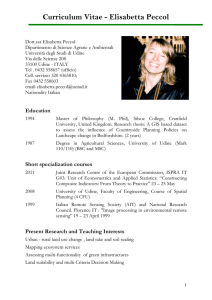
![associazione trio alma mahler n[ever]land percorsi al digitale](http://s3.studylib.net/store/data/007682022_2-8ea580db0e44df4cf293fed7574509bf-300x300.png)
